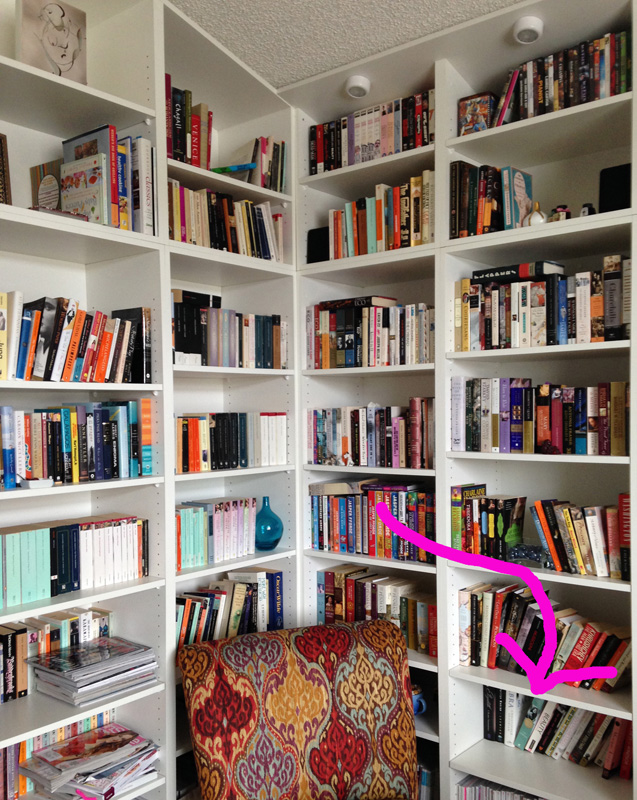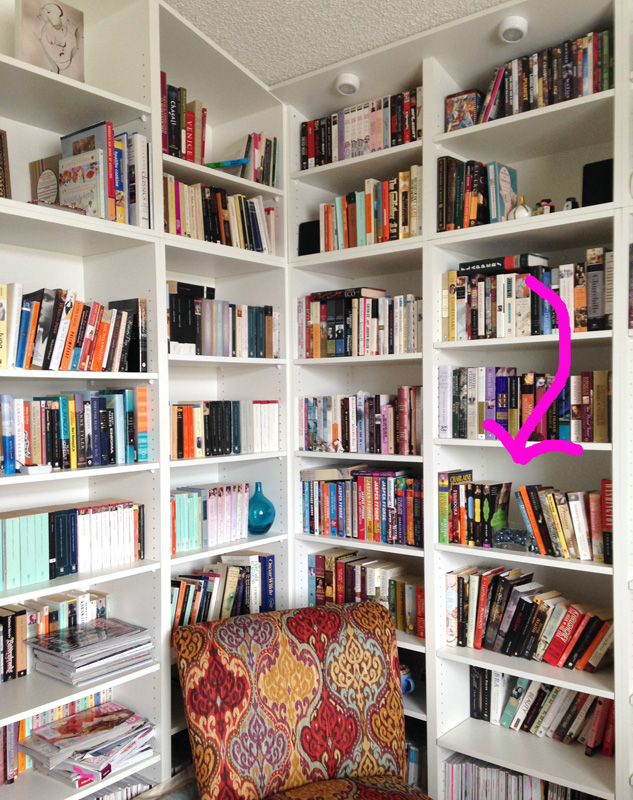Join me on a tour of my book closet … erm … library. Every week – or other week, or whenever I remember to write one of these posts – we’ll take a look at another whack of books I may (or may not) have read.
Time to take a look at a new shelf. How about … this one:
 I call this one my “girly non-fiction” shelf. First up, a few biographies of iconic women. I was a tomboy who grew up into an awkward, geeky, painfully shy adolescent. I know you’re probably rolling your eyes right now, but I was the real deal. Check it:
I call this one my “girly non-fiction” shelf. First up, a few biographies of iconic women. I was a tomboy who grew up into an awkward, geeky, painfully shy adolescent. I know you’re probably rolling your eyes right now, but I was the real deal. Check it:

To this day, I am still waiting for my ugly duckling phase to end. The rational part of my brain is willing to concede that it probably did happen at some point in my early 20s; it just happened too late for my emotional self-image to catch up. I will forever remain a gawky tomboy in my own mind, no matter how much mascara I pile on, or many pairs of Jimmy Choo shoes I own. And my inner tomboy is simply fascinated by beautiful women, who are basically a different species to me. The unconventional beauties (Edith Piaf, Wallis Simpson, Coco Chanel, Barbra Streisand) always interested me even more than the rest because they were proof that personal magnetism can trump society’s silly ideas about what constitutes attractiveness.

Anywaaaaay … the books. Finding a biography of Edith Piaf in English was a challenge, but this one is pretty good. I also enjoyed the film La Vie en Rose (featuring a tour de force performance by Marion Cotillard) but found it too … abbreviated. This biography fills in the gaps, and has a decent number of photos of all the main “characters” in Piaf’s life. Side note: am I the only person who likes to compare how fictional portrayals of famous people line up with their actual appearances?
The Duchess of Windsor: The Secret Life is light on the smutty details of Wallis Simpson’s life, which makes for a more fair and nuanced biography but also an occasionally dry read. But you know that I’m an incorrigible gossip, so take that with a spoonful of salt.
Chanel is a great biography of the legendary Coco, which doesn’t shy away from the less savoury aspects of her life; although the book more or less absolves her of being an actual Nazi collaborator, it makes it clear that she wasn’t entirely innocent of some well-timed opportunism. This biography is a must-read for any fashion lover, particularly anyone wont to worship Chanel.
Elizabeth is one of those perfect, gossipy celebrity biographies. (The author, J. Randy Taraborrelli has written a lot of these, including Jackie, Ethel, Joan: Women of Camelot, which I also enjoyed a lot.) No doubt, the subject matter helps in that regard; the incomparable Ms. Taylor lived a life that could easily rival any soap opera. The same might be said about Marilyn Monroe, but this biography gets bogged down in the more depressing details; it’s still a decent read, but more of a sombre than a fun one. (Side note: I did appreciate that it was written by a woman – too many of Marilyn’s biographers are men, and I think that is sometimes reflected in the way they approach the subject matter. Tangent: I really enjoyed Blonde by Joyce Carol Oates, which is a sort of biographical novel about Marilyn. Equal parts nutty and fantastic).
Barbra and Ava are oddly similar. One was supremely confident in her talent, but insecure about her looks, and the other vice versa. Both are/were pretty badass boss ladies – survivors in an industry that eats up and spits out beautiful women. I would recommend both of these biographies.

I haven’t read Close Up On Sunset Boulevard, but as the title suggests, it’s about the making of the Hollywood classic Sunset Boulevard. I used to be obsessed with stories about old Hollywood, so I imagine this would be right up my alley. Spellbound by Beauty certainly was. It looks at Alfred Hitchcock’s relationships (personal and professional) with his leading ladies, who included film icons like Ingrid Bergman, Joan Fontaine, Grace Kelly, and Marlene Dietrich. It’s a fascinating read, although Hitchcock comes across as something of a controlling jerk, which … may or may not have been the case. I don’t know, because I haven’t read any of his other biographies. But if he’s, like, your favourite director, and you’re invested in him also being a sweet teddy-bear of a guy, you might want to skip this book.
The Way She Looks Tonight takes a quick look at the lives of 5 icons of style: Empress Eugenie of France, Elinor Glyn, Marlene Dietrich, the Duchess of Windsor, and Jacqueline Kennedy. Marian Fowler has written a few other books I really enjoyed (In a Gilded Cage, and Hope: Adventures of a Diamond), and this is no exception: it’s a really fun, engrossing read. Each chapter serves more as a vignette of its subject, rather than a full-blown biography, but it provides a fair bit of detail about each woman’s style and relationship with fashion.
Audrey: Her Real Story belongs on the left side of the shelf, along with the other biographies. It’s a serviceable read – not too boring, not too gossipy. To be fair, the divine Ms. Hepburn didn’t live a life that contained much gossip fodder. Since the author was a man, there isn’t much discussion about her style, which I actually think would have added an interesting dimension to this book. After all, Audrey Hepburn might just be the greatest style icon of all time.
I’m a bit obsessed with the whole WASP/American Prep aesthetic and lifestyle, as only a complete outsider can be. I really wanted to get my hands on the classic Official Preppy Handbook, but it’s out of print, so I settled on True Prep. Written by the same authors as the Handbook, it’s an updated look at Muffy and her gang. It’s pretty funny, though I have a feeling the original might have been better.
Overdressed and Deluxe are my two must-read books about the fashion industry. If you read no other books from today’s post, read these two. Seriously. Overdressed: The Shocking High Price of Fast Fashion looks at the current fast fashion industry, and how it has fundamentally changed the way we shop and dress. It also looks at the impact of our new habits on the environment and the third world countries where our clothes are manufactured. I promise that if you read this book, your mall shopping experiences will never be the same again. Deluxe: How Luxury Lost Its Lustre does the same thing for luxury brands that Overdressed does for fast fashion: exposes its seedy underbelly. I promise that if you read this book, you will never look at Louis Vuitton/Prada/insert-high-end-designer-brand the same way again.
I thought the End of Fashion would be a book in the same vein as Deluxe, but it was somewhat of a disappointment. Its basic premise is that high fashion is now less about craftsmanship (couture being the exclusive domain of the hyper rich) and more about marketing (selling to the middle classes). Each chapter focuses on one or two designers, as case studies for this premise, but the whole book feels less than cohesive. It was an okay read, but nowhere near as interesting as Deluxe.
Beauty: The Twentieth Century looks at the history of women’s style, beauty, and make-up trends over the previous century. (Side note: it’s trippy to me that the 20th century is now the last century, and not just by a few years but by over a decade. Like, whoa. I feel extra old.) This book is like the InStyle version of a history book, or a historical version of InStyle (take your pick): a fun, summer read with lots of pretty pictures. I think it may be out of print, but you might still be able to find it at the library or in a secondhand bookstore.
Oof, that was a whale of a post! Congrats on making it this far … now tell me what you’re reading these days.





